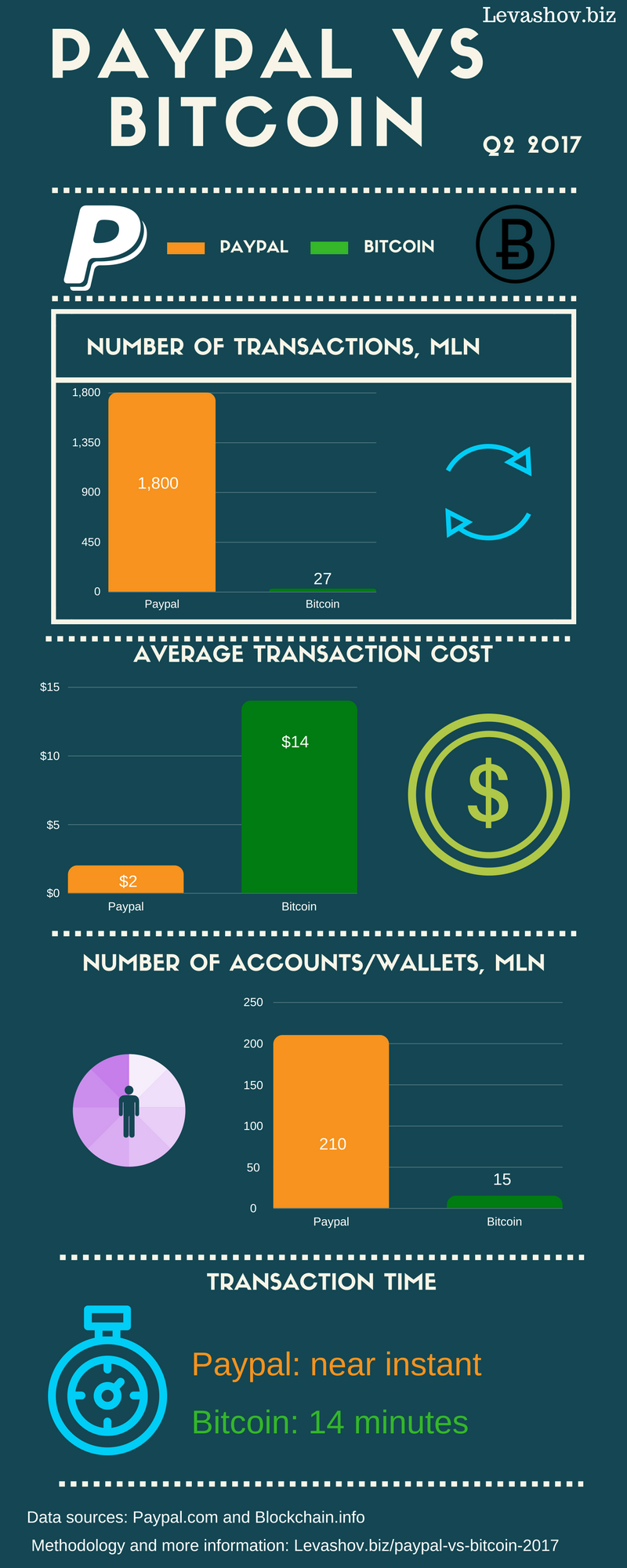
Bitcoin and more in general blockchain technology is a very hot topic now. Every man and his dog either invest in crypto-currency or work in a start-up based on this technology. One of the benefit that often promised by blockchain pundits is a decreased transaction cost.
For example people from Deloitte wrote in their Insights:
By eliminating third party intermediaries and overhead costs for exchanging assets, blockchains have the potential to greatly reduce transaction fees.
It sounds great, but I decided to have a fact check, how does it claim stack to reality.
The oldest blockchain project, Bitcoin exists for several years now and I decided to check how does it perform comparing with one of the biggest centralised electronic transaction systems – Paypal.
The results of my findings are presented in the infographic below.

What do we see: at least at the moment there is no prove that blockchain technology can reduce transaction costs, what we see comparing Paypal and Bitcoin is the opposite – it is much more expensive (7 times in the period researched) than the system based on the centralised database.
If you are interested how did I come to the data above, check the rest of this blog post.
Data sources and methodology
Bitcoin
Information about Bitcoin was taken from Blochain.info the next data sources were used:
- Number of transactions – https://blockchain.info/charts/n-transactions
- Total miners revenue – https://blockchain.info/charts/miners-revenue
- Median confirmation time – https://blockchain.info/charts/median-confirmation-time
- Number of wallet users – https://blockchain.info/charts/my-wallet-n-users
Data series to calculate totals and average were taken for the period from Apr 1st to June 30 2017. Number of wallet is taken at the end of June 2017.
Paypal
Paypal data was taken from official About page for Q2 2017.
Calculation of transaction cost
Transaction cost was calculated the next way.
For Bitcoin it is the ratio of total transaction number to total miners revenue for the specified period of time. The may be an argument that total miners revenue includes both transaction cost and mining reward, but most analysts think that miners are financially motivated by both this components and with mining reward reduction the transaction cost will increase.
The data for July and August confirms that, moreover transaction cost has reached $40 at the end of August.
For Paypal transaction cost is the ratio of revenue to number of transactions.
Transaction time
I haven’t found an official data of Paypal transaction time, but from my experience running own projects and consulting eCommerce merchants it is close to instant if successful, takes several seconds.
With Bitcoin, confirmed transaction time comes to 14 minutes in average in Q2 2017 and sometimes was as high as 29 minutes. Note that we are talking about median time, so some unlucky or to savvy (more you pay the sooner your transaction will be included in block chain) traders had to wait even more.
Final thoughs
At the moment blockchain technology isn’t cheaper than centralised database. Mining requires enormous computer power and to keep blockchain truly safe from hack and control it is how it should be. Paypal is a commercial organisation, so it isn’t subsidised and makes hefty profit. It looks like Paypal manages to run the business more efficiently than Bitcoin, providing users with less expensive transactions. So there is a huge disconnect with the promise of cheap blockchain transactions and reality.
Other thing that is a huge problem for use of Bitcoin in ecommerce transactions is slow transaction time. Customers used to get transaction confirmation instantly, not in 30 or even 14 minutes.
I am far from being an expert in bitcoin and blockchain, but I think these issues are fundamental for use of blockchain in ecommerce.
Thanks for the post! Have you looked into the same sort of comparison but for private blockchains? I am currently struggling to find that kind of information 🙁
Private blockchains rarely use POW method as far as I know, so they may have less issues with speed. However such approach increases chances of abuse or compromise.